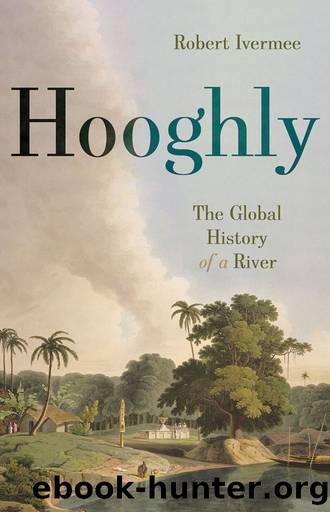Hooghly by Robert Ivermee

Author:Robert Ivermee [Ivermee, Robert]
Language: eng
Format: azw3
Publisher: Hurst
Published: 2020-12-14T16:00:00+00:00
6
CALCUTTA
THE UNFINISHED CONQUEST OF NATURE
At the end of the nineteenth century, the Hooghly was the busiest it had ever been. On the water, simple wooden boats competed with barges and ferries for the transport of people and goods upriver and down, from one bank to the other. Where once nature had held full sway, producing a dense thicket of mango trees, tamarinds, banyans, neems, and palm groves, human life had staked its claim. The banks of the river were studded with villages and towns, temples and ghats. From Murshidabad to Serampore, handsome stone villas and luxuriant gardens claimed much of the riverside terrain. The esplanades of Hooghly, Chinsurah, and Chandernagore evoked faded glory and wealth, while acting as the focal point of bustling industrious towns. The view from the river was enhanced by lofty new constructionsâmost strikingly the Hooghly Imambara, a grand two-storey mosque and ceremony hall bequeathed by a local Shia landowner, Muhammad Mohsin.
The volume of people and activity on the Hooghly increased with proximity to Calcutta. Below Serampore and Barrackpore, both banks of the river were lined with mills, factories, warehouses, and docks, presenting a scene of industrial activity which, in the view of one contemporary observer, ârivalled that of the largest cities of Europeâ.1 Calcutta had long outgrown Fort William and the European quarters surrounding the open groundâthe Maidanâon which it stood, with Chowringhee to the east, Ballygunge and Alipore to the south, and northwards to the great tank in what would become Dalhousie Square. Bowbazaar and Barabazaar developed as commercial and residential centres to the north; the outlying industrial areas of Cossipore, Chitpur, Maniktola, and Garden Reach were integrated into the city as it grew. In 1900, the city stretched six miles along the Hooghlyâs left bank, covering some 20,000 acres of land.2 Opposite, on the right bank of the river, lay the ever growing suburb of Howrah.
By reputation, Calcutta was a âCity of Palacesâ, defined by its attractive European architecture combining elements of the classical and neoclassical, the Gothic and the Baroque. The most palatial residence of all was Government House, opened in 1803 with a porticoed central core and four radiating wings. It was situated just a stoneâs throw from other architectural landmarks: St Johnâs Church, the Town Hall, the Writersâ Building, and the General Post Office among them. The skyline of European Calcutta consisted of âinnumerable towers, spires and pinnaclesâ.3 To focus on the cityâs landmarks, however, obscures the fact that Calcutta was home to a population of staggering size and diversity. In contrast to the wide avenues and open spaces of the colonial âWhite Townâ, most residents lived in narrow lanes in one-storey brick homes or tiled mud huts. Through the course of the nineteenth century the cityâs population grew rapidly: in 1830 it was estimated at 200,000; forty years later, when the first municipal census was taken, it had more than doubled; and in 1901 it was officially recorded as 847,796.4 When suburbs such as Howrah, beyond the cityâs official limits, were added, the total exceeded a million.
Download
This site does not store any files on its server. We only index and link to content provided by other sites. Please contact the content providers to delete copyright contents if any and email us, we'll remove relevant links or contents immediately.
| Africa | Americas |
| Arctic & Antarctica | Asia |
| Australia & Oceania | Europe |
| Middle East | Russia |
| United States | World |
| Ancient Civilizations | Military |
| Historical Study & Educational Resources |
The Third Pole by Mark Synnott(914)
Money for Nothing by Thomas Levenson(898)
The Economist (20210109) by calibre(897)
Christian Ethics by Wilkens Steve;(824)
Made in China by Anna Qu(812)
The Age of Louis XIV: The Story of Civilization by Will Durant(788)
Reopening Muslim Minds by Mustafa Akyol(768)
Nonstate Warfare by Stephen Biddle(766)
100 Posters That Changed The World by Salter Colin T.;(750)
Culture by Terry Eagleton(723)
The Shortest History of China by Linda Jaivin(721)
The Great Pyramid Void Enigma by Scott Creighton(721)
The Irish Buddhist by Alicia Turner(716)
Ideology by Eagleton Terry;(696)
Routledge Handbook of Contemporary India by Knut A. Jacobsen(694)
Sybille Bedford by Selina Hastings(656)
The Jews of Silence: A Personal Report on Soviet Jewry by Elie Wiesel(650)
Objects of Vision by Saab A. Joan;(639)
Banaras: CITY OF LIGHT by Diana L. Eck(631)
